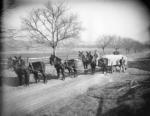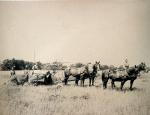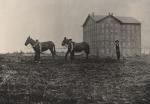Chapter Four: The Transformation of Agriculture
The early European settlers of the Delaware Valley found that many crops they raised back home flourished in Pennsylvania's rich, well-watered soils. Delighted by the productivity of their farms, they believed that the ground was so rich as to be practically inexhaustible. After all, they observed that the Lenape cultivated the same fields for many years without seeming to do anything to improve the soil. In addition, Pennsylvania was a huge province with land so plentiful and cheap that they could easily move on to more fertile ground when the land they were farming was worn.
Some of Pennsylvania's colonists, however, soon depleted the soil through the heavy and repeated planting of wheat and other heavy feeding crops. By the late 1700s, thousands of acres of prime agricultural land in southeastern Pennsylvania had been over-farmed and yields were dropping.
In 1785, to combat the crisis and in other ways improve agriculture in the new nation, gentleman farmers in and around Philadelphia, led by John Beale Bordley, formed the Philadelphia Society for the Promotion of Agriculture. In the first half of the nineteenth century, Bordley and his colleagues campaigned for a variety of reforms. Some, like rotating crops and adding lime or manure to the soil, were already being practiced in certain areas. Others, like the craze for silkworms, died down after their folly became obvious. Many of their programs were just too expensive for ordinary farmers, even if they had wanted to try them.
John Beale Bordley, formed the Philadelphia Society for the Promotion of Agriculture. In the first half of the nineteenth century, Bordley and his colleagues campaigned for a variety of reforms. Some, like rotating crops and adding lime or manure to the soil, were already being practiced in certain areas. Others, like the craze for silkworms, died down after their folly became obvious. Many of their programs were just too expensive for ordinary farmers, even if they had wanted to try them.
In general, the reformers' voices were only partly heeded. Most Pennsylvania farmers found it easier to increase production by clearing more land rather than engaging in more calculated and labor-demanding forms of agriculture. Soil erosion became a serious, state-wide problem, but per-acre yields in most parts of the Commonwealth stayed relatively steady until the twentieth century, even though total production increased dramatically.
The 1800s witnessed the development of machinery to make farm work less difficult and less time consuming. The most celebrated of these inventions was Cyrus McCormick's horse-drawn reaper. But mechanics in towns across the Commonwealth and the nation developed and built their own labor-saving devices to meet the needs of local farmers. By the mid-1800s, there were dozens of these regional manufacturers, including the McClure factory in West Middletown, which began manufacture of the locally designed Ralston thresher in the 1840s. Later in the century the
Ralston thresher in the 1840s. Later in the century the  Doylestown Agricultural Works became a major regional employer. By the late 1800s, the horse-power economy was at its peak; implement sheds appeared on many a farm to house harrows, rakes, and other horse drawn equipment. Horses also powered many stationary devices such as hay forks, which lifted loose hay high into the barn's mow.
Doylestown Agricultural Works became a major regional employer. By the late 1800s, the horse-power economy was at its peak; implement sheds appeared on many a farm to house harrows, rakes, and other horse drawn equipment. Horses also powered many stationary devices such as hay forks, which lifted loose hay high into the barn's mow.
For centuries, the knowledge needed to farm had been passed down from one generation to the next. In the nineteenth century, state agricultural reformers championed the use of science to improve farming and promoted the creation of agricultural societies and schools. New farmers' magazines and popular books extolled the virtues of new techniques and even encouraged innovative designs for farms and farm homes.
Thus inspired, a few well-to-do farmer entrepreneurs turned their lands into "progressive farms," experimental laboratories on which they tried out the latest ideas about farm management, and designed and utilized the newest equipment in their operations. Some, including the Dickey family in what is now the Hopewell Historic District of Chester County, used the water power of local creeks to diversify into manufacturing.
Hopewell Historic District of Chester County, used the water power of local creeks to diversify into manufacturing.
One of the leading agricultural reformers of the era was Judge Frederick Watts, founder and the first president of the Pennsylvania Agricultural Society. An ardent advocate of agricultural reform, Watts built his own model farm near Carlisle and spearheaded the drive for the creation of the
Frederick Watts, founder and the first president of the Pennsylvania Agricultural Society. An ardent advocate of agricultural reform, Watts built his own model farm near Carlisle and spearheaded the drive for the creation of the  Farmers' High School of Pennsylvania, chartered in 1855 to promote farming and "agrarian values." As the first president of the Farmers" High School,
Farmers' High School of Pennsylvania, chartered in 1855 to promote farming and "agrarian values." As the first president of the Farmers" High School,  Evan Pugh made the school a center for the study of agriculture and science. Renamed the Agricultural College of Pennsylvania to make it eligible for funding by the Morrill Land Grant Act of 1862, the school–its named changed to
Evan Pugh made the school a center for the study of agriculture and science. Renamed the Agricultural College of Pennsylvania to make it eligible for funding by the Morrill Land Grant Act of 1862, the school–its named changed to  The Pennsylvania State University in 1953 - would in the twentieth century become a national center of agriculture research and education.
The Pennsylvania State University in 1953 - would in the twentieth century become a national center of agriculture research and education.
Improved farming methods were also part of the curriculum that young women studied at the Pennsylvania School of Horticulture for Women. Opened in 1910, this school in Ambler, Pennsylvania was among the first in the nation to provide professional training for women interested in careers in agriculture, floriculture, fruit tree cultivation, horticulture, and landscape architecture.
Pennsylvania School of Horticulture for Women. Opened in 1910, this school in Ambler, Pennsylvania was among the first in the nation to provide professional training for women interested in careers in agriculture, floriculture, fruit tree cultivation, horticulture, and landscape architecture.
The shift of economic power to manufacturing and transportation and a prolonged agricultural depression in the late 1800s mobilized farmers politically. In response to the growing needs of the Commonwealth's farmers, Governor Daniel H. Hastings in 1895 created the Pennsylvania Department of Agriculture to assist, educate, and protect farmers and consumers. The department inspected and tested animal feed, fertilizers, and food products to assure their purity and safety, ran classes and lectures called "Farmers" Institutes" to inform farmers about the dangers of animal diseases and their treatments, and printed and distributed booklets on topics regarding better farming.
Daniel H. Hastings in 1895 created the Pennsylvania Department of Agriculture to assist, educate, and protect farmers and consumers. The department inspected and tested animal feed, fertilizers, and food products to assure their purity and safety, ran classes and lectures called "Farmers" Institutes" to inform farmers about the dangers of animal diseases and their treatments, and printed and distributed booklets on topics regarding better farming.
In the twentieth century, the Pennsylvania family farm, still the backbone of the state's economy and an important symbol of the American dream, underwent a series of dramatic transformations. In the early 1900s, the introduction of the gasoline powered machinery, especially tractors, revolutionized farming. Farmers gradually gave up their horses. No longer needing to plant the hay and oats that fed them, they reshaped their fields to accommodate the new machinery, and increased the size of their fields and farms.
In the twentieth century, too, scientific agriculture, advocated unsuccessfully - and prematurely - by reformers since the late 1700s, reshaped farming on the grass roots level. Funding provided by the Smith-Lever Act of 1914 created a powerful combination of agricultural research and agricultural extension agents who successfully promoted mechanization, inputs of synthetic chemicals and fertilizers, hybrid seeds, high-yielding animals, and more capital intensive agriculture.
Scientific innovations and industrialization created new opportunities for farmers and new challenges as well. Despite extraordinary advances in agricultural productivity, farmers continued to engage in poor farming techniques. Soil erosion was a problem that dated back to the earliest days of European settlement. As timber companies in the late 1800s clear cut the great hardwood forests of Pennsylvania, the soil that was once held in place by vast expanses of trees washed into streams and rivers.
Soil erosion became a national crisis for farmers on the Great Plains in the early 1930s when a prolonged drought led to the great Dust Bowl. As millions of acres of topsoil were blown away by the hot summer winds, the federal government responded with new laws to protect American rangelands and to conserve soil. Soil erosion problems also prompted six Bucks County farmers in 1939 to contact the United States Soil Conservation Service to make their farms an area for watershed management. Members of the Soil Conservation Service made a number of suggestions to the farmers, including changing some of their farming techniques to aid topsoil retention, which they adopted. The first conservation area of its kind, the 700-acre Honey Hollow Watershed demonstrated how farmers working in cooperation with the federal government could preserve soil, water, and wildlife, and prevent floods.
Honey Hollow Watershed demonstrated how farmers working in cooperation with the federal government could preserve soil, water, and wildlife, and prevent floods.
In the decades that followed, however, agriculture's impact on environment, and people's concern about those impacts, continued to grow. Advocates for watershed protection blamed farmers for nutrient runoff from fertilizer and animal waste. After publication of Rachel Carson's Silent Spring, in 1963, Americans mobilized against the use of dangerous pesticides. Critics pointed to the excess of energy used by fossil-fuel-powered machinery - far more than food energy produced. A small organic farming movement has gained a foothold in the state, but the predominant mode is still industrial. Family farmers were challenged by corporate operations - which led some to incorporate themselves - especially in the poultry business.
Rachel Carson's Silent Spring, in 1963, Americans mobilized against the use of dangerous pesticides. Critics pointed to the excess of energy used by fossil-fuel-powered machinery - far more than food energy produced. A small organic farming movement has gained a foothold in the state, but the predominant mode is still industrial. Family farmers were challenged by corporate operations - which led some to incorporate themselves - especially in the poultry business.
At the dawn of the twenty-first century, agriculture remained Pennsylvania's leading industry, and family owned and operated farms in close proximity to major markets continued to produce food for the Commonwealth, the nation, and the world.
Some of Pennsylvania's colonists, however, soon depleted the soil through the heavy and repeated planting of wheat and other heavy feeding crops. By the late 1700s, thousands of acres of prime agricultural land in southeastern Pennsylvania had been over-farmed and yields were dropping.
In 1785, to combat the crisis and in other ways improve agriculture in the new nation, gentleman farmers in and around Philadelphia, led by
In general, the reformers' voices were only partly heeded. Most Pennsylvania farmers found it easier to increase production by clearing more land rather than engaging in more calculated and labor-demanding forms of agriculture. Soil erosion became a serious, state-wide problem, but per-acre yields in most parts of the Commonwealth stayed relatively steady until the twentieth century, even though total production increased dramatically.
The 1800s witnessed the development of machinery to make farm work less difficult and less time consuming. The most celebrated of these inventions was Cyrus McCormick's horse-drawn reaper. But mechanics in towns across the Commonwealth and the nation developed and built their own labor-saving devices to meet the needs of local farmers. By the mid-1800s, there were dozens of these regional manufacturers, including the McClure factory in West Middletown, which began manufacture of the locally designed
For centuries, the knowledge needed to farm had been passed down from one generation to the next. In the nineteenth century, state agricultural reformers championed the use of science to improve farming and promoted the creation of agricultural societies and schools. New farmers' magazines and popular books extolled the virtues of new techniques and even encouraged innovative designs for farms and farm homes.
Thus inspired, a few well-to-do farmer entrepreneurs turned their lands into "progressive farms," experimental laboratories on which they tried out the latest ideas about farm management, and designed and utilized the newest equipment in their operations. Some, including the Dickey family in what is now the
One of the leading agricultural reformers of the era was Judge
Improved farming methods were also part of the curriculum that young women studied at the
The shift of economic power to manufacturing and transportation and a prolonged agricultural depression in the late 1800s mobilized farmers politically. In response to the growing needs of the Commonwealth's farmers, Governor
In the twentieth century, the Pennsylvania family farm, still the backbone of the state's economy and an important symbol of the American dream, underwent a series of dramatic transformations. In the early 1900s, the introduction of the gasoline powered machinery, especially tractors, revolutionized farming. Farmers gradually gave up their horses. No longer needing to plant the hay and oats that fed them, they reshaped their fields to accommodate the new machinery, and increased the size of their fields and farms.
In the twentieth century, too, scientific agriculture, advocated unsuccessfully - and prematurely - by reformers since the late 1700s, reshaped farming on the grass roots level. Funding provided by the Smith-Lever Act of 1914 created a powerful combination of agricultural research and agricultural extension agents who successfully promoted mechanization, inputs of synthetic chemicals and fertilizers, hybrid seeds, high-yielding animals, and more capital intensive agriculture.
Scientific innovations and industrialization created new opportunities for farmers and new challenges as well. Despite extraordinary advances in agricultural productivity, farmers continued to engage in poor farming techniques. Soil erosion was a problem that dated back to the earliest days of European settlement. As timber companies in the late 1800s clear cut the great hardwood forests of Pennsylvania, the soil that was once held in place by vast expanses of trees washed into streams and rivers.
Soil erosion became a national crisis for farmers on the Great Plains in the early 1930s when a prolonged drought led to the great Dust Bowl. As millions of acres of topsoil were blown away by the hot summer winds, the federal government responded with new laws to protect American rangelands and to conserve soil. Soil erosion problems also prompted six Bucks County farmers in 1939 to contact the United States Soil Conservation Service to make their farms an area for watershed management. Members of the Soil Conservation Service made a number of suggestions to the farmers, including changing some of their farming techniques to aid topsoil retention, which they adopted. The first conservation area of its kind, the 700-acre
In the decades that followed, however, agriculture's impact on environment, and people's concern about those impacts, continued to grow. Advocates for watershed protection blamed farmers for nutrient runoff from fertilizer and animal waste. After publication of
At the dawn of the twenty-first century, agriculture remained Pennsylvania's leading industry, and family owned and operated farms in close proximity to major markets continued to produce food for the Commonwealth, the nation, and the world.












